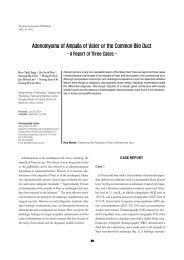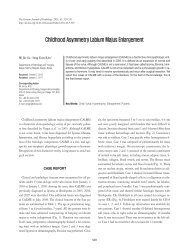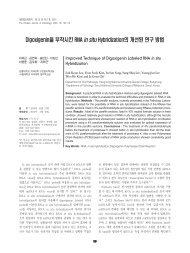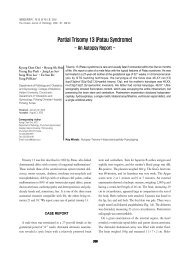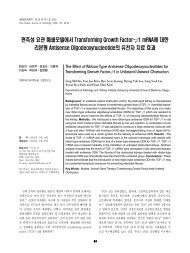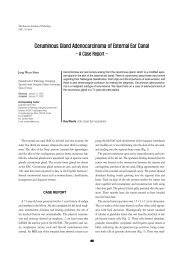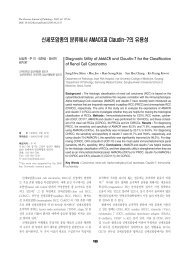Chronic Sclerosing Dacryoadenitis - The Korean Journal of Pathology
Chronic Sclerosing Dacryoadenitis - The Korean Journal of Pathology
Chronic Sclerosing Dacryoadenitis - The Korean Journal of Pathology
Create successful ePaper yourself
Turn your PDF publications into a flip-book with our unique Google optimized e-Paper software.
<strong>The</strong> <strong>Korean</strong> <strong>Journal</strong> <strong>of</strong> <strong>Pathology</strong><br />
2008; 42: 118-22<br />
<strong>Chronic</strong> <strong>Sclerosing</strong> <strong>Dacryoadenitis</strong><br />
- Report <strong>of</strong> 2 Cases -<br />
Ji Eun Kwon∙Sang Kyum Kim<br />
Sang-Ryul Lee 1 ∙Woo-Ick Yang<br />
Department <strong>of</strong> <strong>Pathology</strong> and Brain<br />
Korea 21 Project for Medical Science,<br />
1<br />
Department <strong>of</strong> Ophthalmology, Yonsei<br />
University Health System, Seoul;<br />
2<br />
Department <strong>of</strong> <strong>Pathology</strong>, Seoul<br />
National University Bundang Hospital,<br />
Seongnam, Korea<br />
<strong>Chronic</strong> sclerosing dacryoadenitis is a rare and under-recognized chronic inflammatory disease<br />
<strong>of</strong> the lacrimal gland. We describe 2 patients with a localized type <strong>of</strong> chronic sclerosing<br />
dacryoadenitis. Both patients presented with a slowly growing painless mass <strong>of</strong> the eyelid<br />
mimicking a tumorous lesion. <strong>The</strong> morphologic findings <strong>of</strong> the masses excised under the<br />
clinical diagnosis <strong>of</strong> lymphoma closely recapitulate those <strong>of</strong> chronic sclerosing sialadenitis<br />
. .<br />
(Kuttner tumor). Immunohistochemical staining demonstrated an increased population <strong>of</strong><br />
IgG4-positive plasma cells confirming that this disease also belongs to the spectrum <strong>of</strong> a<br />
recently described IgG4-related sclerosing disease.<br />
Haeryoung Kim 2 118<br />
Received : September 10, 2007<br />
Accepted : October 25, 2007<br />
Corresponding Author<br />
Haeryoung Kim, M.D.<br />
Department <strong>of</strong> <strong>Pathology</strong>, Seoul National University<br />
Bundang Hospital, 300 Gumi-dong, Bundang-gu,<br />
Seongnam 463-707, Korea<br />
Tel: 031-787-7715<br />
Fax: 031-787-4012<br />
E-mail: hkim759@snubh.org<br />
Key Words : Dacryocystitis; Lacrimal apparatus<br />
We recently experienced two cases <strong>of</strong> a chronic inflammatory<br />
condition <strong>of</strong> the lacrimal gland demonstrating clinicopathologic<br />
similarities to chronic sclerosing sialadenitis (CSS). Clinically,<br />
they presented as painless firm eyelid masses mimicking<br />
neoplastic lesions and morphologically they were characterized<br />
by prominent atrophy <strong>of</strong> acini, dense lymphoplasmacytic infiltrates<br />
with scattered germinal centers, and bands <strong>of</strong> sclerosis<br />
with preservation <strong>of</strong> lobular architecture.<br />
Recently, Cheuk et al. 1 reported 6 cases <strong>of</strong> chronic sclerosing<br />
dacryoadenitis (CSD) as a distinct entity for the first time and<br />
they suggested that CSD may be part <strong>of</strong> the spectrum <strong>of</strong> IgG4-<br />
related sclerosing disease which was described by Kitagawa et<br />
al. 2 We herein report on two cases <strong>of</strong> CSD and support the theory<br />
that CSD may be a type <strong>of</strong> IgG4-related sclerosing disease<br />
by demonstrating an increased population <strong>of</strong> IgG4 positive<br />
plasma cells in the lesion.<br />
Case 1<br />
CASE REPORT<br />
A 55-year-old man presented with a 6-month history <strong>of</strong> visual<br />
disturbance <strong>of</strong> the right eye. His past medical history was insignificant<br />
except for hypertension. <strong>The</strong> results <strong>of</strong> full blood count,<br />
differential white blood cell count, and liver function test were<br />
within normal range. Physical examination and magnetic resonance<br />
imaging <strong>of</strong> the brain and orbit revealed a 2.5×2×1.5<br />
cm-sized right lacrimal gland mass. Computed tomography <strong>of</strong><br />
the neck, abdomen, and chest demonstrated no lymphadenopathy.<br />
Under the clinical diagnosis <strong>of</strong> lymphoma, orbitotomy and<br />
mass excision were performed. Frozen section examination suggested<br />
the diagnosis <strong>of</strong> extranodal marginal zone B-cell lymphoma<br />
<strong>of</strong> mucosa-associated lymphoid tissue (MALT). After<br />
the surgery his vision improved without further therapy.<br />
118
<strong>Chronic</strong> <strong>Sclerosing</strong> <strong>Dacryoadenitis</strong> 119<br />
Case 2<br />
A 72-year-old woman presented with bilateral painless firm<br />
eyelid masses <strong>of</strong> 1 month duration. A computerized tomography<br />
scan revealed well-demarcated ovoid masses in bilateral<br />
eyelids (Fig. 1), measuring 1.8 cm and 1.3 cm in the right and<br />
left sides, respectively, in maximal diameter. <strong>The</strong> results <strong>of</strong> full<br />
blood count, differential white blood cell count, and liver function<br />
test were all within normal range and her past medical history<br />
was insignificant. Under the clinical diagnosis <strong>of</strong> lymphoma,<br />
an excision <strong>of</strong> the left upper eyelid lesion was done. No further<br />
therapy was performed and the right eyelid mass has demonstrated<br />
no change.<br />
Grossly, both lesions were well-encapsulated and the cut surfaces<br />
were similar to that <strong>of</strong> a lymph node except for traversed<br />
fibrous bands. Microscopically, both lesions were characterized<br />
by dense lymphoplasmacytic infiltration with scattered lym-<br />
Morphologic findings<br />
Fig. 1. A computerized tomography scan <strong>of</strong> case 2 demonstrates<br />
well-demarcated bilateral ovoid mass lesions in both eyelids.<br />
A<br />
B<br />
C<br />
D<br />
Fig. 2. (A) Low power microscopic findings <strong>of</strong> case 1 show dense lymphoplasmacytic infiltrates with scattered germinal centers, loss <strong>of</strong><br />
acini and prominent septal fibrosis. (B) A residual lobule is seen at the periphery <strong>of</strong> the lymphoplasmacytic infiltrate on medium power<br />
microscopy <strong>of</strong> case 1. (C) Dense periductal sclerotic fibrosis and a germinal center are noted in case 2. (D) High power magnification <strong>of</strong><br />
case 2 shows many mature plasma cells admixed with lymphocytes.
120<br />
Ji Eun Kwon∙Sang Kyum Kim∙Sang-Ryul Lee, et al.<br />
A<br />
B<br />
Fig. 3. Immunohistochemical stains for IgG (A) and IgG4 (B) demonstrate a high proportion <strong>of</strong> IgG-positive plasma cells and IgG4-positive<br />
plasma cells (Case 2).<br />
Table 1. Number <strong>of</strong> IgG4-positive and IgG-positive plasma cells<br />
per high-power field (HPF) and the proportion <strong>of</strong> IgG4-positive/<br />
IgG positive plasma cells in the 2 cases<br />
IgG4 (/HPF) IgG (/HPF) IgG4/IgG (%)<br />
Case 1 173 318 54.4<br />
Case 2 472 652 72.4<br />
phoid follicles containing germinal centers, marked parenchymal<br />
atrophy and dense periductal and septal fibrosis (Fig. 2A-<br />
C). <strong>The</strong> normal lobular pattern <strong>of</strong> the lacrimal gland was vaguely<br />
retained. Many mature plasma cells were scattered among<br />
small lymphoid cells (Fig. 2D). <strong>The</strong>re was no evidence <strong>of</strong> marginal<br />
zone cell proliferation or lymphoepithelial lesions. Eosinophil<br />
infiltration and obliterative phlebitis were not observed.<br />
Immunohistochemical stain results<br />
Immunohistochemical staining using monoclonal antibodies<br />
against human IgG (DakoCytomation, Glostrup, Denmark;<br />
1:1,000) and human IgG4 (Zymed Laboratories Inc, San Francisco,<br />
CA, USA; 1:500) demonstrated abundant IgG-positive and<br />
IgG4-positive plasma cells in both lesions (Table 1, Fig. 3). <strong>The</strong><br />
proportions <strong>of</strong> IgG4-positive/IgG-positive plasma cells were<br />
54.4% and 72.4% for cases 1 and 2, respectively.<br />
DISCUSSION<br />
This report is based on two cases <strong>of</strong> a chronic inflammatory<br />
disease <strong>of</strong> the lacrimal gland with clinicopathologic similarities<br />
. .<br />
to CSS. CSS was originally described by Kuttner 3 in 1896 and<br />
. .<br />
has also been referred as Kuttner tumor due to its usual clinical<br />
presentation as a mass lesion mimicking a salivary gland neoplasm.<br />
Although it is not an uncommon disease, pathologists<br />
sometimes experience difficulties in diagnosis because it is an<br />
under-recognized entity that rarely has been reported in the<br />
English literature. 4,5<br />
Similar organotypic diseases occur in the lacrimal and salivary<br />
glands, probably because they share similar morphologic<br />
and physiologic features. Various types <strong>of</strong> salivary gland neoplasms<br />
commonly occur in the lacrimal glands. CSD can also be<br />
regarded as a lacrimal counterpart <strong>of</strong> CSS as the clinicopathologic<br />
findings are almost identical.<br />
Unlike CSS, CSD has rarely been reported as a distinct entity,<br />
though lacrimal gland swelling has been described in patients<br />
. .<br />
with autoimmune pancreatitis or Kuttner tumor. 2,6-8 In Korea,<br />
Roh and Kim 9 . .<br />
reported a case <strong>of</strong> Kuttner tumor presenting with<br />
bilateral involvement <strong>of</strong> the lacrimal and submandibular glands.<br />
Ocular pathology textbooks currently do not contain descriptions<br />
<strong>of</strong> this disease and thus most clinicians and pathologists<br />
are not aware <strong>of</strong> its existence. Recently, Cheuk et al. 1 described<br />
the clinicopathologic findings <strong>of</strong> 6 cases <strong>of</strong> CSD as a distinct<br />
entity for the first time. According to their data, there was a<br />
female predominance and the mean age <strong>of</strong> the patients was 45.5<br />
years. Five cases presented as bilateral lesions and three cases were<br />
accompanied by salivary gland involvement. Two cases were<br />
associated with generalized lymphadenopathy and one patient<br />
lost her vision due to entrapment <strong>of</strong> the optic nerve by the disease<br />
process. Our two cases occurred in old patients. <strong>The</strong> first<br />
case which presented with blurred vision was a localized CSD<br />
demonstrating no other organ involvement by imaging studies.<br />
<strong>The</strong> second case presented with bilateral disease, and seemed
<strong>Chronic</strong> <strong>Sclerosing</strong> <strong>Dacryoadenitis</strong> 121<br />
to be a localized CSD based on the symptoms and physical examination<br />
findings although meticulous systemic imaging studies<br />
were not performed.<br />
<strong>The</strong> morphologic findings <strong>of</strong> CSD are distinct and a pathologic<br />
diagnosis is usually not difficult if the pathologist is aware <strong>of</strong><br />
this entity. Although CSS and CSD share microscopic findings,<br />
phlebitis - a common feature <strong>of</strong> CSS - has been reported to be<br />
absent in CSD. 1 Our two cases also did not show phlebitis. CSD<br />
should be differentiated from a variety <strong>of</strong> other diseases including<br />
benign lymphoepithelial lesions, Kimura’s disease, sclerosing<br />
variant <strong>of</strong> follicular lymphoma and extranodal marginal zone<br />
B-cell lymphoma <strong>of</strong> mucosa-associated lymphoid tissue. Although<br />
these diseases can be easily excluded by the absence <strong>of</strong> distinct<br />
lymphoepithelial lesions, eosinophil infiltration, neoplastic follicles<br />
with back-to-back arrangement or marginal zone cell proliferation,<br />
frozen section diagnosis can be difficult as in our first case.<br />
In 2005, Kitagawa et al. 2 described for the first time that CSS,<br />
the salivary gland counterpart <strong>of</strong> CSD, belongs to a group <strong>of</strong><br />
IgG4-related sclerosing diseases. IgG4 is the rarest IgG subclass<br />
occupying less than 6% <strong>of</strong> the total IgG fraction in the<br />
serum <strong>of</strong> normal subjects. 10 IgG4-related sclerosing disease is a<br />
recently documented entity and a systemic disease characterized<br />
by high levels <strong>of</strong> serum IgG, lymphoplasma cell infiltration<br />
with high proportions <strong>of</strong> IgG4-positive plasma cells, sclerotic<br />
changes and good response to steroid therapy. <strong>The</strong> prototypic<br />
lesion <strong>of</strong> this entity is autoimmune (sclerosing) pancreatitis<br />
which is occasionally associated with other extrapancreatic sclerosing<br />
lesions such as sclerosing cholangitis, retroperitoneal<br />
fibrosis and sclerosing sialadenitis, and these lesions share common<br />
features <strong>of</strong> elevated serum IgG4 levels and marked IgG4-<br />
positive plasma cell infiltration. 7,8,11 Several investigators placed<br />
all <strong>of</strong> these sclerosing lesions listed above in the spectrum <strong>of</strong><br />
IgG4-related sclerosing disease. Recently, Cheuk et al. 1 suggested<br />
that CSD may also be one <strong>of</strong> these lesions by demonstrating<br />
high serum IgG4 levels and abundant IgG4-positive plasma<br />
cell infiltration in their review <strong>of</strong> 6 cases <strong>of</strong> CSD. In their report,<br />
the ratio <strong>of</strong> IgG4-positive plasma cells out <strong>of</strong> IgG-positive plasma<br />
cells and the number <strong>of</strong> IgG4-positive plasma cells/HPF<br />
ranged from 44% to 99% and from 170 to 799/HPF, respectively.<br />
To confirm the validity <strong>of</strong> CSD as an IgG4-related sclerosing<br />
disease, we analyzed the numbers <strong>of</strong> IgG4-positive plasma<br />
cells in the tissue sections <strong>of</strong> our two patients and showed<br />
that IgG4-positive plasma cells occupied a high proportion <strong>of</strong><br />
IgG-positive plasma cells. <strong>The</strong>re are no established quantitative<br />
criteria regarding the level <strong>of</strong> IgG4-positive plasma cells in tissue<br />
sections for IgG4-related sclerosing disease. However, according<br />
to the report by Kitagawa et al. 2 , in the case <strong>of</strong> CSS, the proportion<br />
<strong>of</strong> IgG4-positive to IgG-positive plasma cells was significantly<br />
higher than in sialolithiasis or Sjogren’s syndrome<br />
. .<br />
(45.8-92.8% vs 0-4.9%), and our results belonged to the range<br />
reported by Cheuk et al. 1 and Kitagawa et al. 2 , thus suggesting<br />
that CSD may be an IgG4-related sclerosing disease.<br />
It has also been suggested that Mikulicz disease-defined as<br />
bilateral symmetrical swelling <strong>of</strong> more than two lacrimal and<br />
major salivary glands with histologic features <strong>of</strong> prominent<br />
mononuclear infiltration-belongs to the spectrum <strong>of</strong> IgG4-related<br />
sclerosing disease due to a high IgG4 level in serum and tissue<br />
sections. 12-14<br />
IgG4-related sclerosing diseases have shown good responses<br />
to steroid therapy. 7 <strong>The</strong>refore, a high index <strong>of</strong> suspicion for CSD<br />
by clinicians and an increased awareness <strong>of</strong> the existence <strong>of</strong> CSD<br />
by pathologists could avoid unnecessary aggressive surgery.<br />
REFERENCES<br />
1. Cheuk W, Yuen HK, Chan JK. <strong>Chronic</strong> sclerosing dacryoadenitis:<br />
part <strong>of</strong> the spectrum <strong>of</strong> IgG4-related sclerosing disease? Am J Surg<br />
Pathol 2007; 31: 643-5.<br />
2. Kitagawa S, Zen Y, Harada K, et al. Abundant IgG4-positive plasma<br />
cell infiltration characterizes chronic sclerosing sialadenitis<br />
. .<br />
(Kuttner tumor). Am J Surg Pathol 2005; 29: 783-91.<br />
. . . . . .<br />
3. Kuttner H. Uber entzundliche tumoren der submaxilla-speicheldruse.<br />
Bruns’ Beitr Klin Chir 1896; 15: 815-28.<br />
. .<br />
4. Seifert G. Tumor-like lesions <strong>of</strong> the salivary glands. <strong>The</strong> new WHO<br />
classification. Pathol Res Pract 1992; 188: 836-46.<br />
. .<br />
5. Chan JK. Kuttner tumor (chronic sclerosing siadenitis) <strong>of</strong> the submandibular<br />
gland: an underrecognized entity. Adv Anat Pathol<br />
1998; 5: 239-51.<br />
6. Boccato P, Blandamura S, Midena E, Carolla C. Orbital ectopic<br />
lacrimal gland tissue simulating a neoplasm. Report <strong>of</strong> a case with<br />
fine needle aspiration biopsy diagnosis. Acta Cytol 1992; 36: 737-43.<br />
7. Kamisawa T, Okamoto A. Autoimmune pancreatitis: proposal <strong>of</strong><br />
IgG4-related sclerosing disease. J Gastroenterol 2006; 41: 613-25.<br />
8. Kamisawa T, Nakajima H, Egawa N, et al. IgG4-related sclerosing<br />
disease incorporating sclerosing pancreatitis, cholangitis, sialadenitis<br />
and retroperitoneal fibrosis with lymphadenopathy Pancreatology<br />
2006; 6: 132-7.<br />
. .<br />
9. Roh JL, Kim JM. Kuttner tumor: unusual presentation with bilateral<br />
involvement <strong>of</strong> the lacrimal and submandibular glands. Acta<br />
Otolaryngol 2005; 125: 792-6.<br />
10. Van der Zee JS, Aalberse RC. Immunohistochemical characteristics
122<br />
Ji Eun Kwon∙Sang Kyum Kim∙Sang-Ryul Lee, et al.<br />
<strong>of</strong> IgG4 antibodies. N Engl Reg Allergy Proc 1988; 9: 31-3.<br />
11. Kamisawa T, Funata N, Hayashi Y, et al. A new clinicopathological<br />
entity <strong>of</strong> IgG4-related autoimmune disease. J Gastroenterol 2003;<br />
38: 982-4.<br />
12. Yamamoto M, Ohara M, Suzuki C, et al. Elevated IgG4 concentrations<br />
in serum <strong>of</strong> patients with Mikulicz’s disease. Scand J Rheumatol<br />
2004; 33: 432-3.<br />
13. Yamamoto M, Harada S, Ohara M, et al. Clinical and pathological<br />
differences between Mikulicz’s disease and Sjogren’s syndrome.<br />
Rheumatology (Oxford). 2005; 44: 227-34.<br />
14. Yamamoto M, Takahashi H, Ohara M, et al. A new conceptualization<br />
for Mikulicz’s disease as an IgG4-related plasmacytic disease.<br />
Mod Rheumatol 2006; 16: 335-40.



